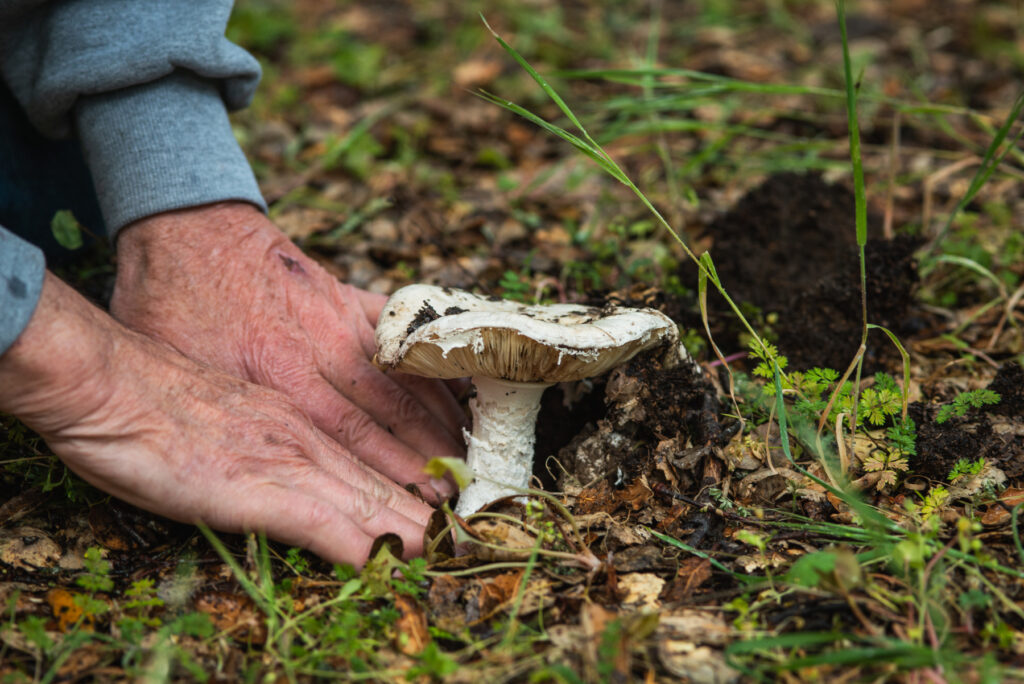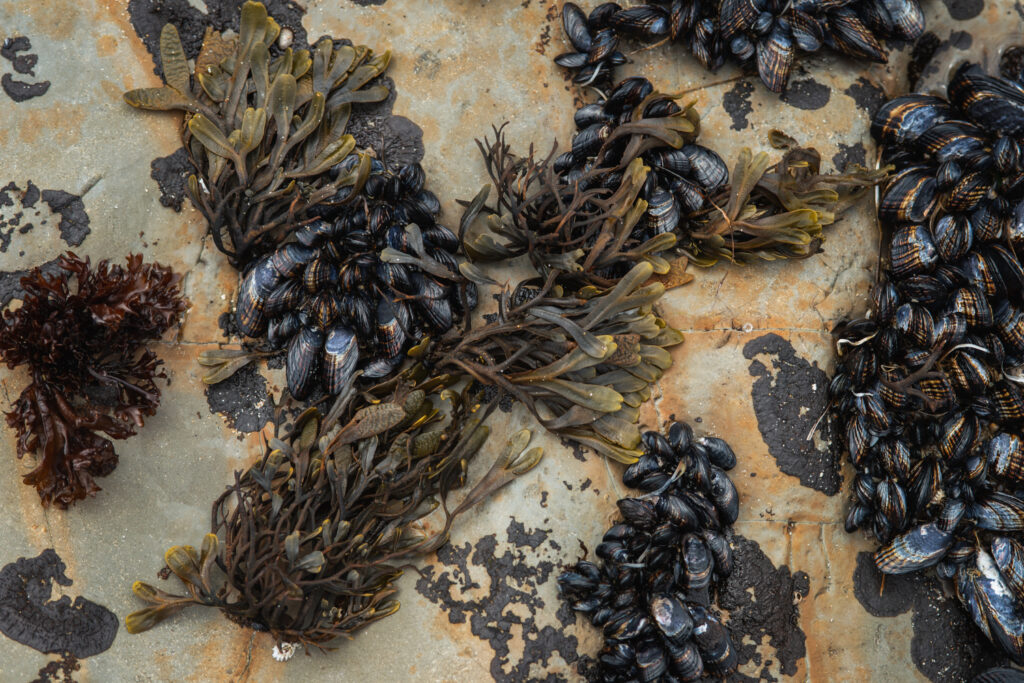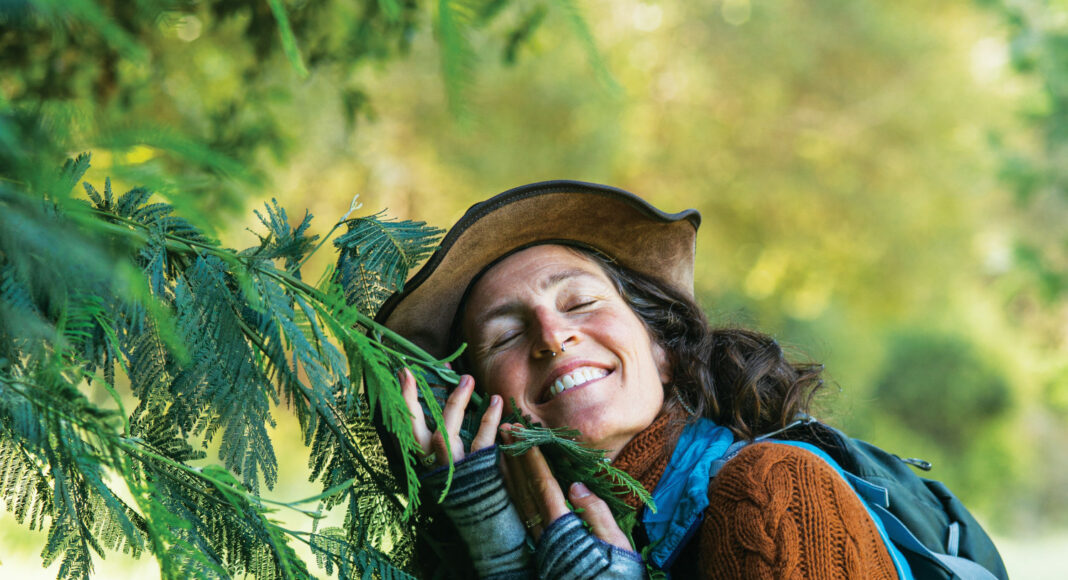Before our walk through the woods, Caitlin Wild places one hand on her heart and one on the Earth.
“It’s just sending this place some real heartfelt gratitude, in recognition of all the wild ones, seen and unseen,” she says. “Extending our gratitude to the native people who call this place home and stewarded this land for thousands of years before us. May we walk humbly, remembering our place in the family of things, and listen to the wisdom of the wild ones.”
Wild, the founder of Mountain Sea Adventures, started guiding edible and medicinal plant and fungi walks about five years ago. She began foraging and getting to know the species around her—“making friends,” as she calls it—10 years before that.
“It all started with mushrooms,” she says with a smile. “I went mushroom hunting with some friends, and we found a bunch of edible mushrooms. And I just could not believe you could go outside and find food everywhere. Delicious, diverse, healthy food that evolved here.”
Mushrooms are the first to draw many foragers into the wild world of gathering. But with its kelp-covered shorelines, oak-dotted chaparral, redwood forests and coastal wetlands, the areas around Santa Cruz provide much more.
GOING WILD
Gathering wild foods in Santa Cruz is nothing new—Northern California and the Central Coast have nurtured communities for more than 10,000 years. In this area, Awaswas and Mutsun-speaking peoples cared for hundreds of types of wild plants for many generations.
But the forced removal of native people from their lands and genocide at the hands of Spanish and American settlers made passing down ecological and cultural knowledge difficult.
“The thousands and thousands of people that were missionized and then emancipated after secularization, they really did not have access to many of the resources that their parents or grandparents were familiar with,” says Alan Leventhal, an ethnohistorian and archaeologist who has worked with the Muwekma Ohlone Tribe in the San Francisco Bay Area since 1980 and the Amah Mutsun Tribal Band since 1989.
Today, some Indigenous nations reunite with their ancestral lands through land trusts. The Amah Mutsun Land Trust conserves and restores traditional knowledge and stewardship practices, and the Muwekma Ohlone Preservation Foundation similarly seeks to reconnect the tribe’s people with the land and restore culture.
“It takes a very long time to establish a relationship with those plants. Our people did not domesticate plants intentionally,” says Valentin Lopez, Chairman of the Amah Mutsun Tribal Band. “Whenever you domesticate a plant, you dominate it, and you subordinate that plant to be lesser than you. We should never do that with plants. Plants are our relatives.”
Viewing plants as equals, Lopez’s ancestors would leave a gift or an offering whenever they took something.
“It’s a reciprocal relationship,” he explains. “We have a responsibility to take care of this plant—to be responsible for them. So it’s not about going out and just randomly taking. That’s really disrespectful, and it should never be done that way.”
Tobacco, songs and prayers are a few examples of traditional offerings, but Lopez declines to give too many details.
“I don’t want people thinking that I’m giving them the right to gather, or that I’m teaching them the native way of gathering,” he says.
When asked about ethical ways for non-native people to forage, he emphasizes the importance of learning what plants mean.
“That plant is a gift from Creator, and that plant is a relative of ours,” he says. “And we have an obligation.”
He recommends the book Tending the Wild by Kat Anderson as a way to learn more about indigenous relationships with plants.
As far as what to focus on, “maybe people should learn how to gather the non-native plants only, and I can’t help much there,” he says with a chuckle.
KNOW YOUR SPORES
There are plenty of non-native organisms to choose from, but starting out with identifications can feel daunting. Most foragers recommend getting to know one species inside and out first. The rest follows naturally.
For many people, especially in Santa Cruz, that first species is some kind of mushroom.
“We have this very active and wonderful, dedicated Fungus Federation here,” says Maya Elson, who leads mushroom hunts, applied mycology workshops and plant foraging walks with Mycopsychology.
Most major cities in California have mycology clubs, but the Fungus Federation of Santa Cruz stands out. The club hosts the annual Fungus Fair, forays, talks and workshops. Longtime members also contribute to the science of mycology at large, publishing identification books and discovering new species.
But even though mushrooms are “something that has a little more of a presence in the everyday person’s mind around here,” Elson says the average person still suffers from mycophobia.
“I have a lot of people who are afraid to even touch mushrooms, afraid to let their kids get excited about them,” she says. “And I just find that really sad. It’s a real barrier to us finding our place within our ecosystem and building relationships with our ecosystem.”
While not wanting to be alarmist, Elson and other experts emphasize the importance of cross-checking identifications, and being 100% certain that foraged finds are safe before eating them. Most people know that putting the wrong mushroom in your mouth could make for a very bad day.

Phil Carpenter, a retired chemist who has led mushroom walks at UCSC for over 30 years, consults with the local hospitals on mushroom poisonings. He recalls one deadly season in particular.
“There was a rumor going around Santa Cruz that all amanitas—a genus of mushroom—are hallucinogenic,” he says with a sigh. People were accidentally poisoning themselves with death caps, one of the deadliest mushrooms in the world.
“It’s a horrible way to go,” he says. “Basically, your liver dissolves, and you die in your own toxins.”
The solution, he says, is more education.
“It’s being cursed with a little bit of knowledge, and not enough to make a proper decision.”
Many of the calls he gets come from panicked parents whose toddler has just eaten something.
“They rush them to the hospital, and they terrorize these poor kids. And half the time, they’ve got a good edible,” he says with a chuckle.
Carpenter started foraging as a young child with his family. He encourages people who want to get into it as adults to join a club like the Fungus Federation.
“Get to know people who know what they’re doing, and learn from them,” he says.
Some of his favorite species to find in California are porcini, morels, chanterelles and candy caps. The latter tastes almost like maple syrup when dried, and are often added to desserts such as cookies and ice creams.
ECO GATEWAY
One of the challenges to mushroom foraging in the area is finding legal locations. Most public lands do not allow harvesting.
“There’s just a real limitation to places that we can legally forage,” says Elson. “And then those places are often way over-harvested.”
Some of this strict regulation comes from a lack of understanding of fungi, foragers say.
“When you’re doing it right—the way I teach people—it’s actually regenerative,” says Elson, who studied fungal biology at Evergreen State College in Washington.
“A mushroom is a fruiting body of this stuff called mycelium,” she explains. The mushrooms pop up to spread spores, which are “little microscopic packets of genetic information that float around in the wind,” similar to tiny seeds.
By collecting mushrooms in baskets or bags with holes and walking around the forest, “you’re like a little spore fairy,” says Elson.
Since most of the organism lives in the soil as the root-like mycelium, people should take care not to disturb the ground around mushrooms. That can do more damage than over-harvesting, Elson cautions.
Most of these mycelia live in symbiosis with specific plants. They exchange sugars, nutrients and minerals through their root systems.
This partnership is why foragers look for specific trees when searching for certain mushrooms. And it’s how mushrooms become a gateway into getting to know the rest of an ecosystem.
“Mushrooming has given me a completely different way of looking at things,” says Phil Carpenter. “The interrelationship between the fungi and the trees, and knowing your trees—it has made me a better naturalist.”
LESSONS FROM THE LAND
As I walk through the forest with Caitlin Wild, she stops frequently to point out “friends.” One thing that begins to stand out among the mushrooms and trees is the variety of fresh greens.
Wood sorrel, also known as sour grass, has a tart, almost lemony taste. Curly dock, a wavy-leaved weed native to Europe, also tastes a bit sour, and can become mouth-puckeringly bitter as they mature.
Claytonia, also known as miner’s lettuce, provides a sweeter flavor.
“The younger claytonia looks pretty distinct from the older claytonia,” says Wild. “So you want a guidebook that really shows the life cycle of the plants or mushrooms that you’re harvesting.”
Wild advises using two or more books to cross-reference identifications. She stays away from phone apps because of spotty cell service and high margins of error.
“Be 100% sure before ingesting anything,” she says. “And if you’re ever in doubt, don’t eat them.”
Non-native edible flower blossoms like wild radish, common mustard and nasturtium provide a pop of color and delicate floral taste.
Just like with any foraging, when harvesting greens, it’s important to stay aware of your impact.
“Only harvest abundant species. Only harvest, maximum, one-quarter of what you see. Only take what you need—duh,” says Wild. “And make sure you have permission.”
She points to a small beetle on a claytonia leaf.
“What I mean by that is sometimes you get a very clear ‘no.’”
An animal on the plant, a spider web or a poisonous species nearby all signal a forager to move along.
We come across a patch of poison oak.
“I consider poison oak—or what I call “protector oak,” because they protect the ecosystem from human invasion—to be a master teacher,” says Wild.
She calls plants and fungi “they” rather than “it.”
“If we really believe that the whole ecosystem is alive, which of course I do, I don’t want to objectify them by calling them ‘it,’” she explains.
Wild traces the roots of that practice to Indigenous languages.
“What that does is it actually brings you into a relationship with them, and when we objectify and call things ‘it,’ it’s much easier to destroy and not take care of them,” she says.
Every few feet, we pass new plants with new uses. I ask Wild whether she has a favorite thing to look for.
“The thing that I’m looking for,” she says with a laugh. Wild’s searches change with the seasons. And despite her deep familiarity with her surroundings, she still learns constantly.
“You can dive deep into it and over the course of your lifetime never be done,” she says.
In addition to medicinal and edible plant and mushroom walks, Wild leads longer immersive trips into nature. But you don’t need to go on a backpacking trip to connect with the non-human world, she says. “You can just go outside and take your shoes off or put your hands on the Earth.”
SEE FOOD
Some professional foragers, like Wild and Elson, make their living guiding people through nature. Others collect commercially.
As the founder of Seaquoia, Ian O’Hollaren spends his days harvesting wild kelp. He became interested in organic fertilizers while studying horticulture in Hawai’i and learned about the use of seaweed. When he returned to California, he bought an identification book and started learning different species.
Along the West Coast, cold, nutrient-rich water wells up from the deep sea and supports a huge diversity of seaweeds.
“Dwarf rockweed, sea palm, kombu, nori, wakame, cat tongue, grapestone, splendid iridescent, bladderwrack…” he says, reciting species found in the intertidal zone—the space between low and high tides.
Seaweeds, which are actually algae rather than true plants, fall into three categories: red, brown and green. Although we might have trouble digesting some of them, no known seaweeds are considered poisonous.
O’Hollaren, who branched out from fertilizers to culinary applications, has a commercial license and harvests away from towns, river mouths and other potential sources of pollutants. He’s also careful not to collect from no-take marine protected areas and avoids rare species.

“Everyone should always look into their local regulations and be mindful,” O’Hollaren says.
When he collects, he prunes just a bit from each plant.
“Cleaning them off is how I look at it—kind of taking some weight off the plant,” he explains.
O’Hollaren works with farmers, restaurants and cosmetic companies on everything from fertilizer to kelp beer.
“It’s been really fun exploring and creating these relationships with different companies and watching them grow and create their ideas,” he says.
For home kitchens, O’Hollaren suggests using kelps like any other vegetable. Starting with crunchier varieties can make the process a bit less intimidating.
Dwarf rockweed, for example, gives a mild briny flavor without any of the sliminess you might expect from seaweed. It turns bright green when cooked and stays just as crisp as when raw.
The Seaquoia website lists other ideas and recipes for the kelp-curious.
GATHERING COMMUNITY
During one of my first forays to collect seaweed in the intertidal, a stranger cracked an urchin shell open and offered me a taste of uni. A few moments later, another stranger was describing the best way to steam mussels. As we meandered across the exposed reef, we exchanged tips and stories.
“It’s a great opportunity to bring generations of people together,” says Peter Mu, an investment advisor who spends his spare time free diving, foraging and organizing programs for the Fungus Federation.
The communities built through foraging help keep people and ecosystems safe.
“When people are interested in participating, every step along the way there should be communication about doing it legally, doing it appropriately, getting connected to readily available regulations,” says Mu.
“This is why groups like the Fungus Federation of Santa Cruz exist. Our purpose is to educate the public about how to enjoy the resources of fungi safely,” he continues.
Staying on top of state and county regulations—especially within the marine environment—can prove tricky. Mu has watched fisheries shrink and close over time, and things change seasonally.
For plants and mushrooms, policies often stay more consistent. But seasons and abundances are shifting as the climate changes.
“Climate change is definitely reflected in the mushrooms,” says Carpenter. With warmer temperatures and changing rainfall patterns, “we’re seeing more Southern California mushrooms sliding up here, and we’re seeing other things move north,” he says. “And the fungal health relates to forest health.”
Wild and Elson both agree.
“In the small amount of time I’ve been foraging—the past 15 years—the seasons have been changing,” says Wild. “The mushroom season is way shorter. The rains come later, and they are far fewer than when I started.”
She and Elson both suggest supporting Indigenous communities and land trusts as one way to help protect the environment.
“When you’re fed by the ecosystem, you naturally want to feed it back,” says Elson. “There are a lot of ways that we can support our ecosystem, and it’s really urgent that we do so right now.”













